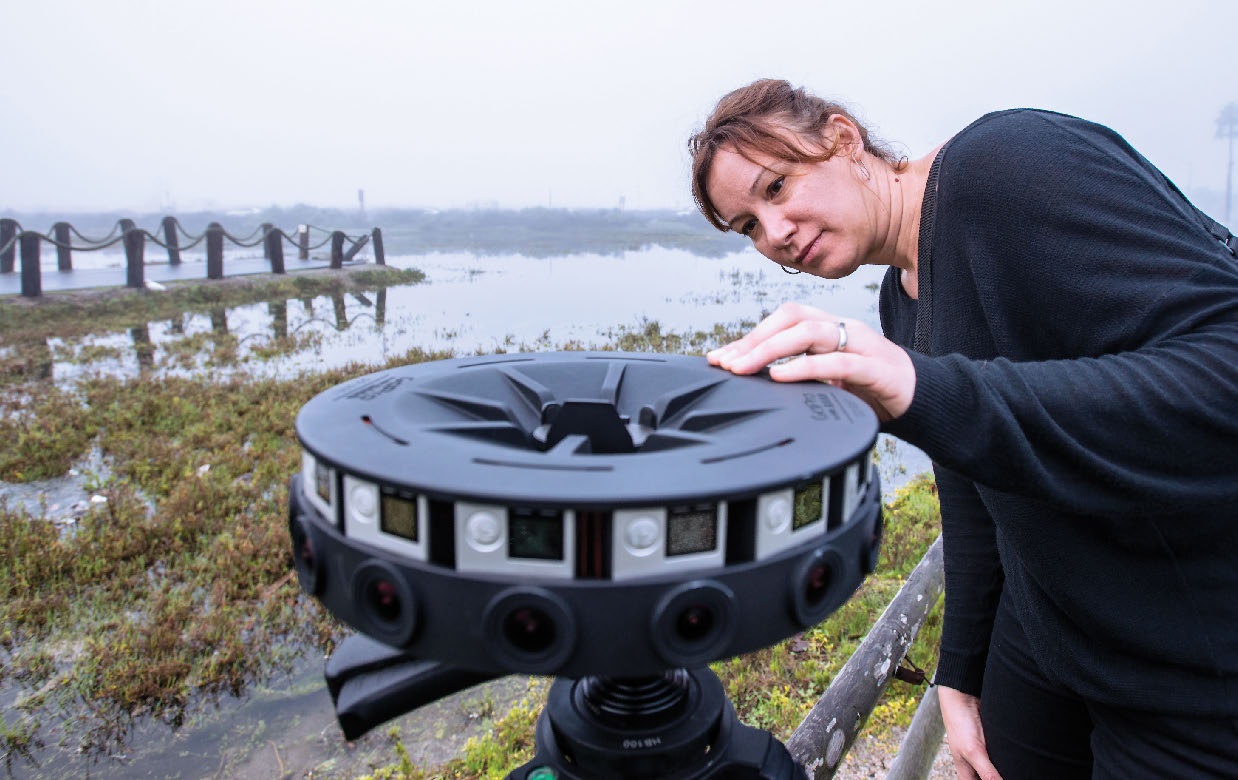Columbia College | Columbia University in the City of New York
Oceanographer Juliette Finzi Hart ’96 Shows the (Virtual) Reality of Climate Change
Imagine seeing your favorite beach swallowed by the ocean. Your distress — the visceral kind of reaction that spurs people to action — is what oceanographer Juliette Finzi Hart ’96 is looking to elicit from residents of Southern California through the use of virtual reality.
Hart, director of outreach at the U.S. Geological Survey’s Pacific Coastal and Marine Science Center, films 360-degree videos that show SoCal beaches as they are expected to look with higher sea levels. During king tides — the highest tides of the year, which serve as proxies for future everyday conditions — she captures dramatic images of flooded beaches using a device equipped with 16 GoPro action cameras, and then uploads the videos to YouTube. Using an inexpensive virtual-reality headset, viewers can feel as though they are standing on their local beach some 30 years from now.

Mark Rightmire / Orange County Register
Hart, who joined USGS in July 2016, also helped create a temporary virtual-reality installation on the Santa Monica Pier. Known as The OWL, it consisted of two free-standing viewers, similar to coin-operated binoculars, each containing a tablet. From November 2016 to January 2017, visitors were able to peer into the viewer to see how sea level increases will transform the iconic area.
CCT Print Extras
Patrick Barnard, research director for the Climate Impacts and Coastal Processes Team at USGS, lauds the way Hart has embraced technology and innovation. “She immerses the audience in the challenges our coastal communities face, making it personal,” he says. “These VR experiences burn into people’s memories and move them toward understanding and action far better than any flat map or bullet point on a PowerPoint slide can.”
Hart’s outreach efforts also include more conventional methods. She regularly speaks to government agencies, city councils, citizen organizations, students and other groups about the dangers of climate change. Her presentations are based on USGS’s Coastal Storm Modeling System, or CosMos, which projects coastal flooding and erosion in California.
While the audiences change, the message is the same: Climate change and rising sea levels call for immediate response. For homeowners, that might involve flood-proofing their properties, while for city planners, it might mean updating infrastructure. As part of those conversations, Hart often finds herself clarifying the connection between climate change and extreme weather events like Harvey, Irma and Maria, the powerful storms that devastated communities in Texas, Florida and Puerto Rico, respectively, during the 2017 hurricane season.
“While you can’t say a specific event is due to climate change,” says Hart, “you can say the observed intensity of the recent 2017 hurricane season is consistent with what climate scientists have been predicting for years.” Hart, who lives in Manhattan Beach, Calif., with her husband and two young daughters, majored in art history at the College and spent her first year after graduation working for an art consultant in London. Unfulfilled in that field and long interested in science, she started volunteering on whale-watching boats off Cape Cod, Mass., a place she frequented in the summertime while growing up in New Jersey.
A research position at the local Provincetown Center for Coastal Studies followed. There, in an effort to understand why endangered right whales were not better protected against ship strikes and entanglements, Hart discovered a disconnect between policymakers and scientists. With the goal of helping to bridge that gap, she earned a Ph.D. in ocean science at the University of Southern California. “Ultimately, I didn’t want to be just in the lab,” she says. “I wanted to be out there taking available science and helping people understand it.”
Hart began working in outreach as an assistant research professor with USC’s Sea Grant Program, which studies the interaction between the ocean and other bodies of water and the urban areas that surround them. It was there that she began dabbling in VR with the help of her husband, a web professional and gaming enthusiast.
Regardless of the medium, for Hart, making science accessible is the most rewarding part of her work. “It’s always a really great feeling when I finish a presentation in which I feel I’ve connected with people and helped bring the science into their world,” she says.
Nathalie Alonso ’08, from Queens, is a freelance journalist and an editorial producer for LasMayores.com, Major League Baseball’s official Spanish language website. She is a regular contributor to CCT.
Issue Contents
Published three times a year by Columbia College for alumni, students, faculty, parents and friends.
Columbia Alumni Center
622 W. 113th St., MC 4530, 6th Fl.
New York, NY 10025
212-851-7852
cct@columbia.edu
Columbia Alumni Center
622 W. 113th St., MC 4530, 4th Fl.
New York, NY 10025
212-851-7488
ccalumni@columbia.edu

